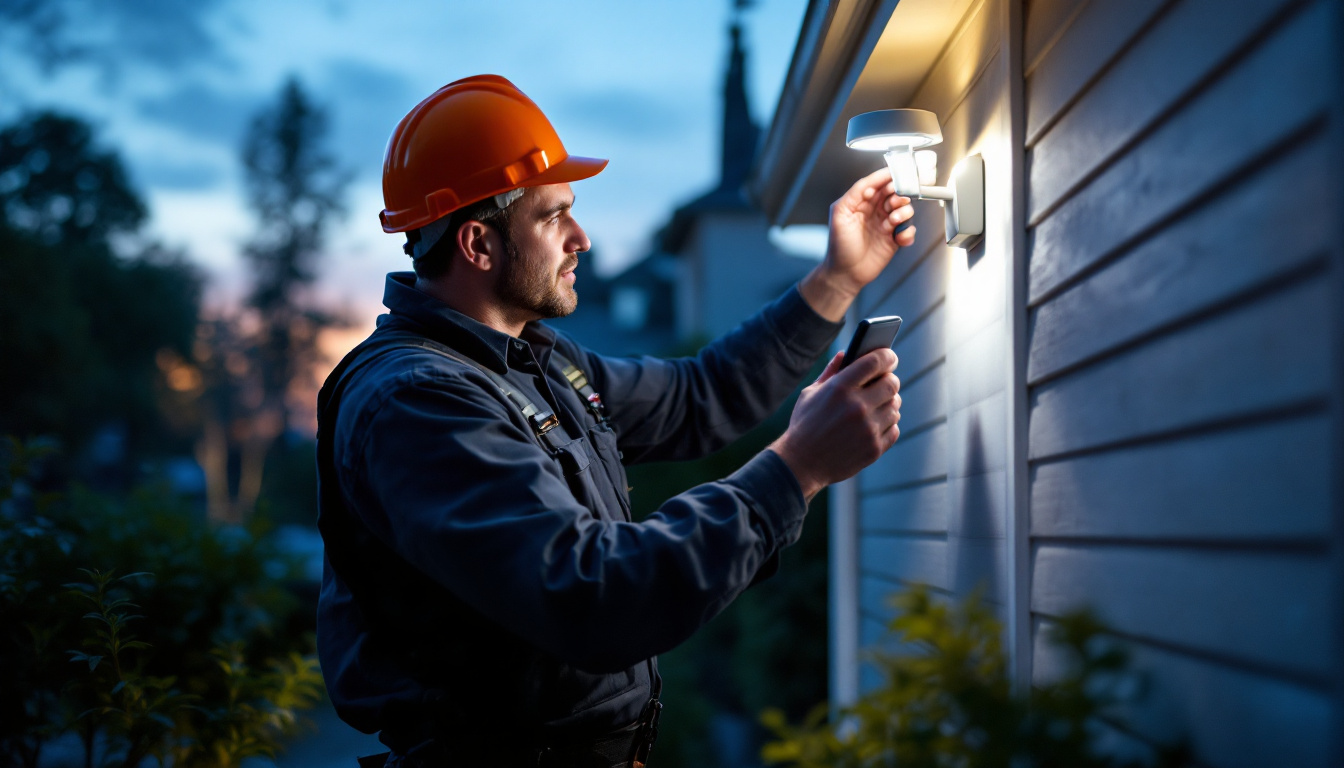
In the evolving landscape of lighting technology, motion-activated lights have emerged as a popular choice for both residential and commercial applications. For lighting contractors, understanding the intricacies of these devices is essential to meet client expectations and deliver efficient solutions. This comprehensive guide will delve into the various aspects of motion-activated lights, from their functionality to installation tips, ensuring that lighting contractors are well-equipped to navigate this dynamic field.
Motion-activated lights are designed to illuminate an area automatically when they detect movement. This technology not only enhances security but also promotes energy efficiency by ensuring lights are only on when needed. The core components of these systems include sensors, lights, and control mechanisms, each playing a vital role in the overall functionality. The integration of smart technology has further revolutionized motion-activated lighting, allowing for remote control and programmable settings that can adapt to various user preferences and environmental conditions.
There are several types of motion sensors used in these lighting systems, each with distinct advantages and applications. The most common types include passive infrared (PIR), microwave, and dual technology sensors. Understanding the differences can help contractors recommend the best option for their clients. For instance, PIR sensors are particularly effective in residential settings where human presence is the primary concern, while microwave sensors are favored in commercial spaces due to their ability to detect movement through obstacles, such as walls or foliage.
PIR sensors detect changes in infrared radiation emitted by objects, making them ideal for detecting human movement. Microwave sensors, on the other hand, emit microwave pulses and measure the reflection off moving objects, offering a broader detection range. Dual technology sensors combine both PIR and microwave technologies, providing enhanced reliability and reducing false alarms. These advanced sensors can be particularly beneficial in environments where pets or small animals might trigger a single technology sensor, thus ensuring that only significant movements activate the lights.
Motion-activated lights find utility in various settings, including residential, commercial, and industrial environments. In residential applications, they are commonly used for outdoor security lighting, illuminating pathways, and enhancing safety around entrances. Beyond just security, these lights can also be programmed to create a welcoming atmosphere when homeowners approach their doors, adding a layer of convenience to daily life. Additionally, they can be integrated with home automation systems, allowing users to control lighting remotely or set schedules for when lights should activate.
In commercial settings, these lights can be employed in parking lots, building perimeters, and even in warehouses to improve visibility and security. The use of motion-activated lights can significantly reduce energy costs for businesses by ensuring that lights are only active during operational hours or when employees are present. Industrial applications often leverage motion-activated lights for safety in high-traffic areas, ensuring that workers have adequate lighting when moving about. Furthermore, these systems can be linked to alarm systems, providing an additional layer of security by alerting personnel to unauthorized movements during off-hours. The versatility of these lights makes them a valuable addition to any contractor’s offerings, as they can be tailored to meet the specific needs of various clients and environments, enhancing both safety and efficiency.
Integrating motion-activated lights into a project can offer numerous benefits, both for contractors and their clients. These advantages range from energy savings to enhanced security, making them an attractive option for various installations.
One of the most significant benefits of motion-activated lights is their energy efficiency. By ensuring that lights are only on when needed, these systems can significantly reduce electricity consumption. This not only lowers utility bills for clients but also contributes to a more sustainable approach to lighting.
Moreover, many modern motion-activated lights come equipped with LED technology, which further enhances energy savings. LEDs consume less power and have a longer lifespan compared to traditional incandescent bulbs, making them a smart choice for contractors looking to provide value to their clients.
Security is a primary concern for many clients, and motion-activated lights can play a crucial role in deterring potential intruders. The sudden illumination triggered by movement can startle trespassers and alert homeowners or business owners to unusual activity.
Additionally, these lights can be integrated with security systems, providing real-time alerts and enhancing overall safety. For contractors, offering motion-activated lights as part of a security solution can be a compelling selling point.
Proper installation of motion-activated lights is critical to their performance and effectiveness. Contractors must consider various factors, including sensor placement, wiring, and environmental conditions, to ensure optimal functionality.
The placement of motion sensors is crucial for maximizing coverage and minimizing false triggers. Sensors should be installed at a height that allows for a clear line of sight while avoiding obstructions such as trees or walls. Additionally, contractors should consider the detection range of the sensors, ensuring they cover the desired area without unnecessary overlap.
It is also essential to assess the environment where the lights will be installed. For instance, areas with high foot traffic may require different sensor settings compared to quieter zones. Understanding the specific needs of each installation can lead to more effective lighting solutions.
When installing motion-activated lights, contractors must ensure that the wiring is appropriate for the specific type of light and sensor being used. This includes considering the voltage requirements and ensuring that the power supply is adequate for the installation.
In some cases, contractors may opt for solar-powered motion-activated lights, which can be an excellent choice for outdoor applications. These lights require careful consideration of solar panel placement to ensure they receive adequate sunlight for charging.
While motion-activated lights offer numerous benefits, they are not without their challenges. Contractors should be prepared to address common issues that may arise during installation and use.
One of the most common challenges with motion-activated lights is false triggering. This can occur due to various factors, including pets, passing vehicles, or even strong winds. To mitigate this issue, contractors should select sensors with adjustable sensitivity settings, allowing clients to customize the detection range based on their specific environment.
Additionally, positioning sensors strategically can help reduce false alarms. For example, placing sensors away from busy streets or areas with heavy foliage can minimize unnecessary activations.
Another challenge contractors may face is a limited detection range, which can hinder the effectiveness of motion-activated lights. To address this, it is essential to choose the right type of sensor for the application. For larger areas, contractors may need to install multiple sensors to ensure comprehensive coverage.
Furthermore, understanding the specifications of each sensor can help contractors make informed decisions. Some sensors may have adjustable detection ranges, allowing for greater flexibility in installation.
The rise of smart home technology has opened new avenues for motion-activated lights. Integrating these lights with smart systems can enhance functionality and provide clients with greater control over their lighting solutions.
Smart motion sensors can connect to home automation systems, allowing clients to control their lights remotely via smartphone apps. This integration enables users to customize settings, monitor activity, and receive alerts when motion is detected.
Additionally, smart motion sensors can be programmed to work in conjunction with other smart devices, such as security cameras and alarms, creating a comprehensive security solution. For contractors, offering smart motion-activated lights can help differentiate their services and appeal to tech-savvy clients.
Some advanced motion-activated lights come equipped with energy monitoring features, allowing clients to track their energy usage in real-time. This data can be invaluable for clients looking to reduce their energy consumption and make informed decisions about their lighting systems.
By integrating these features, contractors can provide added value to their clients, helping them understand their energy usage and encouraging more sustainable practices.
Regular maintenance is essential to ensure the longevity and performance of motion-activated lights. Contractors should educate clients on proper care and provide guidance on troubleshooting common issues.
Encouraging clients to perform routine checks on their motion-activated lights can help identify potential issues before they become significant problems. This includes checking for dirt or debris on sensors, ensuring that lights are functioning correctly, and replacing batteries in battery-operated models.
Contractors can also recommend seasonal maintenance, especially for outdoor installations. Clearing away foliage and debris can help maintain optimal sensor performance and prevent false triggers.
When clients encounter issues with their motion-activated lights, contractors should be prepared to offer troubleshooting tips. Common problems may include lights not turning on, frequent false triggers, or sensors failing to detect motion.
Providing clients with a simple troubleshooting guide can empower them to address minor issues independently. For example, if lights are not turning on, checking power connections or ensuring that the sensor is not obstructed can often resolve the problem.
Motion-activated lights represent a versatile and efficient lighting solution that can enhance security and energy efficiency for clients. For lighting contractors, understanding the various aspects of these systems—from types of sensors to installation considerations—can lead to successful projects and satisfied clients.
By staying informed about the latest advancements in motion-activated lighting technology and integrating smart features, contractors can position themselves as industry leaders. With the right knowledge and skills, lighting contractors can effectively harness the benefits of motion-activated lights, ensuring they meet the diverse needs of their clientele.
Ready to elevate your lighting projects with the most efficient motion-activated lights on the market? Look no further than LumenWholesale, where we provide contractors with top-tier, specification-grade lighting products at unbeatable wholesale prices. Say goodbye to local distributor markups and hello to our premium selection that meets rigorous industry standards. With LumenWholesale, you get the reliability and performance your clients demand, paired with the convenience of hassle-free bulk purchasing and free shipping. Don’t compromise on quality or value—click now to explore our extensive range and secure Wholesale Lighting at the Best Value for your next project.

Discover the ultimate guide to mastering recessed exterior lights with insights from top lighting contractors.

Discover how LED sign lights can revolutionize the way lighting contractors manage costs.

Discover the essentials of battery-powered exit signs in this comprehensive guide for lighting contractors.

Discover the key insights lighting contractors need to meet client expectations when selling light poles.